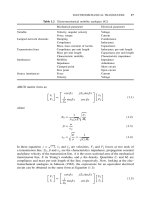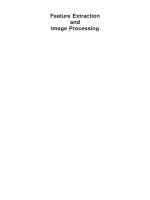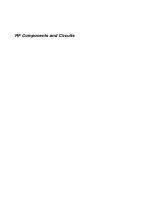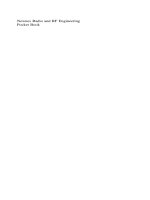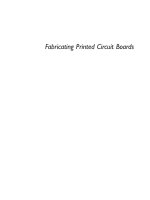carr, j. j. (2002). rf components and circuits
Bạn đang xem bản rút gọn của tài liệu. Xem và tải ngay bản đầy đủ của tài liệu tại đây (2.52 MB, 415 trang )
RF Components and Circuits
RF Components and Circuits
Joseph J. Carr
Newnes
O
XFORD
A
MSTERDAM
B
OSTON
L
ONDON
N
EW
Y
ORK
P
ARIS
S
AN
D
IEGO
S
AN
F
RANCISCO
S
INGAPORE
S
YDNEY
T
OKYO
Newnes
An imprint of Elsevier Science
Linacre House, Jordan Hill, Oxford OX2 8DP
225 Wildwood Avenue, Woburn, MA 01801-2041
First edition 2002
Copyright © Joseph J. Carr and Elsevier Science Ltd 2002. All rights reserved
The right of Joseph J. Carr to be identified as the author of this work
has been asserted in accordance with the Copyright, Designs and Patents Act 1988
No part of this publication may be reproduced in any material form
(including photocopying or storing in any medium by electronic means
and whether or not transiently or incidentally to some other use of this
publication) without the written permission of the copyright holder
except in accordance with the provisions of the Copyright, Designs
and Patents Act 1988 or under the terms of a licence issued by the
Copyright Licensing Agency Ltd, 90 Tottenham Court Road, London,
England W1T 4LP. Applications for the copyright holder’s written
permission to reproduce any part of this publication should be addressed
to the publishers
British Library Cataloguing in Publication Data
A catalogue record for this book is available from the British Library
ISBN 0 7506 48449
Published in conjunction with Radio Society of Great Britain,
Lambda House, Cranborne Road, Potters Bar, Herts, EN6 3JE. UK
www.rsgb.org.uk
For information on all Newnes publications
visit our website at: newnespress.com
Cover illustration supplied by Coilcraft Europe Ltd
Composition by Genesis Typesetting, Rochester, Kent
Printed and bound in Great Britain
Foreword ?
Remembering Joe Carr, K4IPV ?
Preface ?
Part 1 Introduction 1
1 Introduction to radio frequencies 1
What are the ’radio frequencies’? 1
Why are radio frequencies different? 1
What this book covers 1
2 Signals and noise 2
Types of signals 2
Static and quasistatic signals 2
Periodic signals 2
Repetitive signals 2
Transient signals and pulse signals 9
Fourier series 9
Waveform symmetry 11
Transient signals 17
Sampled signals 18
Noise 21
Signal-to-noise ratio (SNR or Sn) 27
Noise factor, noise figure and noise temperature 29
Noise factor (FN) 29
Noise figure (NF) 30
Noise temperature ( Te) 30
Noise in cascade amplifiers 31
Noise reduction strategies 31
Noise reduction by signal averaging 32
Example 32
3 Radio receivers 3
Signals, noise and reception 3
The reception problem 35
Strategies 37
Radio receiver specifications 38
Origins 38
Crystal video receivers 3.4
Tuned radio frequency (TRF) receivers 3.4
Superheterodyne receivers 3.4
Heterodyning 42
Front-end circuits 44
Intermediate frequency (IF) amplifier 44
Detector 44
Audio amplifiers 44
Receiver performance factors 44
Units of measure 45
Input signal voltage 45
dBm 45
dBmV 46
dB 46
V 46
Noise 46
Signal-to-noise ratio (SNR or Sn) 46
Receiver noise floor 47
Static measures of receiver performance 47
Sensitivity 47
Selectivity 50
Front-end bandwidth 52
Image rejection 53
1st IF rejection 54
IF bandwidth 54
IF passband shape factor 55
Distant frequency (’ultimate’) rejection 57
Stability 57
AGC range and threshold 58
Dynamic performance 58
Intermodulation products 59
-1 dB compression point 60
Third-order intercept point 60
Dynamic range 62
Blocking 63
Cross-modulation 63
Reciprocal mixing 64
IF notch rejection 64
Internal spurii 65
Part 2 Circuits 2
4 RF amplifiers 4
Noise and preselectors/preamplifiers 70
Amplifier configurations 70
Transistor gain 70
Classification by common element 72
Common emitter circuits 72
Common collector circuits 73
Common base circuits 73
Transistor biasing 73
Collector-to-base bias 74
Emitter bias or ˛self-bias 74
Frequency characteristics 75
JFET and MOSFET connections 75
JFET preselector 76
VHF receiver preselector 79
MOSFET preselector 79
Voltage-tuned receiver preselector 81
Broadband RF preamplifier for VLF, LF and AM BCB 81
Push-pull RF amplifiers 84
Types of push-pull RF amplifiers 84
Actual circuit details 86
Broadband RF amplifier (50 ohm input and output) 88
5 Mixers 5.1
Linear-vs-non-linear mixers 5.1
Simple diode mixer 94
The question of ˛balance 95
Unbalanced mixers 95
Single balanced mixers 95
Double balanced mixers 95
Spurious responses 95
Image 95
Half IF 96
IF feedthrough 96
High-order spurs 97
LO harmonic spurs 98
LO noise spurs 98
Mixer distortion products 98
Third-order intercept point 99
Calculating intercept points 101
Mixer losses 101
Noise figure 102
Noise balance 102
Single-ended active mixer circuits 103
Balanced active mixers 104
Gilbert cell mixers 113
Passive double-balanced mixers 114
Diplexers 116
Bandpass diplexers 117
Double DBM 5.36
Image reject mixers 5.36
VHF/UHF microwave mixer circuits 124
6 Oscillators 6
Feedback oscillators 6
General types of RF oscillator circuits 126
Piezoelectric crystals 128
Piezoelectricity 129
Equivalent circuit 129
Crystal packaging 129
Temperature performance 133
Room temperature crystal oscillators 133
Temperature-compensated crystal oscillators 133
Oven-controlled crystal oscillators 133
Short-term stability 134
Long-term stability 134
Miller oscillators 134
Pierce oscillators 136
Butler oscillators 138
Colpitts oscillators 143
Overtone oscillators 145
Frequency stability 147
Temperature 149
Thermal isolation 149
Avoid self-heating 150
Other stability criteria 150
Use low frequencies 150
Feedback level 150
Output isolation 150
DC power supply 150
Vibration isolation 153
Coil core selection 153
Coil-core processing 153
Air core coils 154
Capacitor selection 154
Tempco circuit 155
Varactors 155
Frequency synthesizers 157
Reference section 159
Frequency synthesizer section 159
Output section 159
Automatic level control (ALC) 160
7 IF amplifiers and filters 7
IF filters: general filter theory 7
L C IF filters 163
Crystal filters 165
Crystal ladder filters 167
Monolithic ceramic crystal filters 170
Mechanical filters 170
SAW filters 171
Filter switching in IF amplifiers 173
Amplifier circuits 174
Cascode pair amplifier 175
˛Universal IF amplifier 175
Coupling to block filters 178
More IC IF amplifiers 179
MC-1590 circuit 179
SL560C circuits 180
FM IF amplifier 180
Successive detection logarithmic amplifiers 180
8 Demodulators 8.2
AM envelope detectors 8.2
AM noise 190
Synchronous AM demodulation 190
Double sideband (DSBSC) and single sideband
(SSBSC) suppressed carrier demodulators 190
Phasing method 197
FM and PM demodulator circuits 197
Foster Seeley discriminator 197
Ratio detector 200
Pulse counting detector 8.23
Phase-locked loop FM/PM detectors 206
Quadrature detector 206
Part 3 Components 3
9 Capacitors 9
Units of capacitance 9
Breakdown voltage 211
Circuit symbols for capacitors 211
Fixed capacitors 212
Paper dielectric capacitors 212
Mylar dielectric capacitors 212
Ceramic dielectric capacitors 213
Mica dielectric capacitors 214
Other capacitors 214
Variable capacitors 215
Air variable main tuning capacitors 217
Capacitor tuning laws SLC-vs-SLF 219
Special variable capacitors 220
Split stator capacitors 221
Differential capacitors 221
˛Transmitting variable capacitors 222
Variable capacitor cleaning note 222
Using and stabilizing a varactor diode 223
Varactor tuning circuits 223
Temperature compensation 9.21
Varactor applications 230
10 Inductors C
Inductor circuit symbols C
Inductance and inductors 233
Inductance of a single straight wire 234
Combining two or more inductors 235
Air-core inductors 236
Solenoid wound air-core inductors 237
Adjustable coils 237
Winding your own coils 239
Amidon Associates coil system 239
Using ferrite and powdered iron cores 240
Materials used in cores 240
Powdered iron 241
Ferrite materials 242
Making the calculations 242
Toroid cores 244
Example 246
Inductors and transformers 247
Broadband RF transformers 249
Winding toroid cores 251
Counting turns 251
Winding styles 252
Stabilizing the windings 254
Mounting toroids 254
Mounting multiple coils 254
Special mounting methods 256
High-power transformers 257
Binocular cores 257
Turns counting on binocular cores 259
Winding styles on binocular cores 259
Winding a binocular core 260
Ferrite rods 261
Bobbing along with a bobbin 263
Ferrite beads 264
Mounting ferrite beads 266
11 Tuning and matching 11
Vectors for RF circuits 11
L C resonant tank circuits 270
Series resonant circuits 270
Parallel resonant circuits 271
Tuned RF/IF transformers 273
Construction of RF/IF transformers 274
Bandwidth of RF/IF transformers 276
Choosing component values for L C resonant tank
circuits 279
The tracking problem 281
The RF amplifier/antenna tuner problem 281
Example 282
The local oscillator (LO) problem 283
Trimmer capacitor method 284
Impedance matching in RF circuits 285
Transformer matching 286
Resonant transformers 287
Resonant networks 288
Inverse-L network 289
-network 289
Split-capacitor network 290
Transistor-to-transistor impedance matching 291
12 Splitters and hybrids 12
RF power combiners and splitters 12
Characteristics of splitter/combiner circuits 12
Resistive splitter/combiner 294
Transformer splitter/combiner 295
How it works 298
Mismatch losses 298
Modified VSWR bridge splitter/combiner 299
90 degree splitter/combiner 301
Transmission line splitter/combiners 301
90 degree transmission line splitter/combiner 303
Hybrid ring ˛rat-race network 304
RF hybrid couplers 305
Applications of hybrids 306
Combining signal sources 306
Bi-directional amplifiers 2
Transmitter/receiver isolation 2
Quadrature hybrids 2
RF directional couplers 312
Conclusion 316
13 Monolithic microwave integrated circuits 13.1
Internal circuitry 319
Basic amplifier circuit 320
Other MAR-x circuits 321
Multiple device circuits 327
Mast-mounted wideband preamplifier 333
Broadband HF amplifier 333
Part 4 Measurement and techniques 4
14 Measuring inductors and capacitors XC
VSWR method XC
Voltage divider method 339
Signal generator method 340
Frequency shifted oscillator method 342
Using RF bridges 344
Maxwell bridge 345
Hay bridge 346
Schering bridge 347
Finding parasitic capacitances and inductances 347
Conclusion 350
15 RF power measurement 15
Power units 15
Types of RF power measurement 15
Methods for measuring RF power 352
Thermistor RF power meters 352
Bolometers 353
Self-balancing bridge instruments 355
Thermocouple RF power meters 356
Diode detector RF power meters 358
Circuits 360
Practical in-line bridge circuits 360
Micromatch 15.12
Monomatch 363
The Bird Thruline sensor 364
Calorimeters 366
Substitution flow calorimeters 367
Absolute flow calorimeters 367
Micropower and low power measurements 370
Error and uncertainty sources 372
Mismatch loss and mismatch uncertainty 372
16 Filtering against EMI/ RFI 16
Shielding 16
Filter circuits 16
R C EMI/RFI protection 376
Feedthrough capacitors 377
General guidelines 380
17 Noise cancellation bridges 17
A simple bridge circuit 383
Bibliography 1998
Index 353æ5
Foreword
Remembering Joe Carr, K4IPV
This book represents the last published work of an extraordinary man – a teacher, mentor,
engineer, husband, father, and friend.
To say that Joe’s life, work, and loving spirit enriched many lives is an understatement
indeed. A relentless communicator, both through the written word and through Amateur
Radio, Joe redefined the word ‘prolific’ with 1,000 or more published articles and papers
and nearly 100 books on topics ranging from science and technology to matters of history
and faith.
Like his colleagues, family, and innumerable friends, his editors revered him. When Joe
undertook a project, we could count on its being completed on time, in good shape, and
exactly as promised. He met his deadlines, accepted criticism graciously, and lived each
day as ready to learn from others as he was to teach.
He spoke ill of no one, cherished his professional and personal relationships, honored
the work of others, and never failed to laugh at himself.
Writing these words means admitting that Joe is really gone. After 20 years of working
with him, that is a difficult thing to do. But like so many other ‘Silent Keys’ who have
preceded him, Joe will continue to educate and inform new generations of radio engineers
and Amateurs worldwide through his rich legacy of written work. Rather than regret that
these new enthusiasts could not have known him firsthand, we can hope they will come
to know him through this book.
Dorothy Rosa
KA1LBO
Former Managing Editor, ham radio magazine
In memory of Joe Carr (1943–2000) the staff of Newnes would like to dedicate this book
to Joe’s family, friends and colleagues.
We would also like to acknowledge with thanks the work undertaken by Dave Kimber
to prepare the manuscript for publication.
Matthew Deans
Newnes Publisher
Preface
This is a book on radio frequency (RF) circuits. RF circuits are different from other circuits
because the values of stray or distributed capacitances and inductances become
significant at RF. When circuit values are calculated, for example, these distributed values
must be cranked into the equations or the answer will be wrong . . . perhaps by a
significant amount. It is for this reason that RF is different from low frequency circuits.
Joseph J. Carr
Part 1
Introduction
1
Introduction to radio
frequencies
This book grew out of a series in a British magazine called Electronics World/Wireless World.
In fact, most of the material presented in this book first appeared, at least in general form,
in that publication. Other material was written new for this book.
What are the ‘radio frequencies’?
The radio frequencies (RF) are, roughly speaking, those which are above human hearing,
and extend into the microwave spectrum to the edge of the infrared region. That means
the RF frequencies are roughly 20 000 Hz to many, many gigahertz. In this book, we will
assume the radio frequencies are up to about 30 GHz for practical purposes.
There are radio frequencies below 20 kHz, however. In fact, there are radio navigation
transmitters operating in the 10 to 14 kHz region. The difference is that the waves
generated by those stations are electromagnetic waves, not acoustical waves, so humans
cannot hear them.
Why are radio frequencies different?
Why are radio frequencies different from lower frequencies? The difference is largely due
to the fact that capacitive and inductive stray reactances tend to be more significant at
those frequencies than they are at lower frequencies. At the lower frequencies, those stray
or distributed reactances exist, but they can usually be ignored. Their values do not
approach the amount required to establish resonance, or frequency responses such as high
pass, low pass or bandpass. At RF frequencies, the stray or distributed reactances tend to
be important. As the frequency drops into the audio range (1–20 kHz), and the ultrasonic
range (20–100 kHz) the importance of stray reactances tends to diminish slightly.
What this book covers
We will look at a number of different things regarding RF circuits. But first, we will take
a look at signals and noise. This sets the scene for a general look at radio receivers. Most
radio frequency systems have one or more receivers, so they are an important type of
4 RF Components and Circuits
circuit. They also include examples of many of the individual RF circuits we will be
looking at. So Part 1 is an introduction.
It is hard to say very much about RF circuits without talking about the components, but
the special RF components don’t make much sense unless you already know something
about the circuits. So which should come first? (Think of chickens and eggs!) The way
round this is to put circuits in Part 2 and components in Part 3, but then think of them as
running in parallel rather than one after the other. So you can swap between them, but
because this is a paper-based book we have to print Part 3 after Part 2.
Part 2 looks at the various types of RF circuits in roughly the order a radio signal sees
them as it goes through a normal superhet receiver. Many of these circuits are also used
in transmitters, test equipment and other RF stuff but there isn’t enough space to go into
all that in this book.
Part 3 mainly deals with the sort of components you won’t see in lower frequency or
digital circuits. Radio frequency is a bit unusual because some components, mainly
various types of inductors, can’t always be bought ‘off the shelf’ from catalogues but
instead have to be made from parts such as bits of ferrite with holes in them and lengths
of wire. So I will give you design information for this.
We finish up by looking at some RF measurements and techniques in Part 4.
One big important RF topic has been left out of this book – antennas. This is because
doing this properly would make the book much too long, but a quick look would not tell
you enough information to be useful. You can learn about antennas from my book
Antenna Toolkit, second edition (published by Newnes/RSGB, Oxford 2001). This includes
a CD-ROM to help you with antenna calculations.
Now, let’s get started . . .
2
Signals and noise
Types of signals
The nature of signals, and their relationship to noise and interfering signals, determines
appropriate design all the way from the system level down to the component selection
level. In this chapter we will take a look at signals and noise, and how each affects the
design of amplification and other RF circuits.
Signals can be categorized several ways, but one of the most fundamental is according
to time domain behaviour (the other major category is frequency domain). We will therefore
consider signals of the form v = f(t) or i = f(t). The time domain classes of signals include:
static, quasistatic, periodic, repetitive, transient, random, and chaotic. Each of these categories
has certain properties that can profoundly influence appropriate design decisions.
Static and quasistatic signals
A static signal (Fig. 2.1A) is, by definition, unchanging over a very long period of time
(T
long
in Fig. 2.1A). Such a signal is essentially a DC level, so must be processed in low
drift DC amplifier circuits. This type of signal does not occur at radio frequencies because
it is DC, but some RF circuits may produce a DC level, e.g. a continuous wave, constant
amplitude RF signal applied to an envelope detector.
The term quasistatic means ‘nearly unchanging’, so a quasistatic signal (Fig. 2.1B) refers
to a signal that changes so slowly over long times that it possesses characteristics more
like static signals than dynamic (i.e. rapidly changing) signals.
Periodic signals
A periodic signal (Fig. 2.1C) is one that exactly repeats itself on a regular basis. Examples
of periodic signals include sine waves, square waves, sawtooth waves, triangle waves,
and so forth. The nature of the periodic waveform is such that each waveform is identical
at like points along the time line. In other words, if you advance along the time line by
exactly one period (T), then the voltage, polarity and direction of change of the waveform
will be repeated. That is, for a voltage waveform, V(t) = V(t + T).
Repetitive signals
A repetitive signal (Fig. 2.1D) is quasiperiodic in nature, so bears some similarity to the
periodic waveform. The principal difference between repetitive and periodic signals is
TIME
T
+V
0 V
V1
A
TIME
T
+V
0 V
V1
B
6 RF Components and Circuits
Figure 2.1 Various types of signal: (A) static.
Figure 2.1 (B) quasistatic.
TIME
T
+V
0 V
V1
T1
T 2
T
V
T1
= V
T2
= V1
T = T2 – T1
C
TIME
T
+V
0 V
V1
D
Signals and noise 7
Figure 2.1 (C) periodic.
Figure 2.1 (D) quasiperiodic.
TIME
T
+V
0 V
V1
NOISE
E
TIME
T
+V
0 V
T1
T2 T2
DC COMPONENT
NOISE RIDING
ON A DC LEVEL
T1 >> T2
F
8 RF Components and Circuits
Figure 2.1 (E) spectrum of single frequency.
Figure 2.1 (F) two pulses.
